Bengaluru: Hundreds of students, science teachers, researchers, and professors gathered at Bengaluru’s Jawaharlal Nehru Centre for Advanced Scientific Research campus to celebrate CNR Rao’s 90th birthday on 30 June. It’s the institute’s very own ‘Teacher’s Day,’ celebrated for 17 years in honour of the famed Indian scientist and co-founder of JNCASR. But this year is special—the institute has opened a large gallery dedicated to honouring his life’s work and achievements.
“My birthday was alright,” said a modest Rao, whose work has been foundational to many advances in materials science over the last few decades, including carbon nanotubes.
A stroke a couple of years ago has left the structural chemist with a severe speech impediment, but his academic tenacity is undiminished. At 90, Rao shows no inclination to ‘slow down’. When he’s not immersed in institute work, he’s busy publishing papers and collaborating with his wife, author and Kannada science communicator Indumati Rao.
The new gallery is covered from top to bottom with his numerous awards from multiple countries, along with photographs with legendary scientists like CV Raman and Vikram Sarabhai, Indian prime ministers he worked with as a scientific advisor, and heads of states of Russia, Japan, UK, France, as well as Pope John Paul 2 and the late Queen Elizabeth II of England.
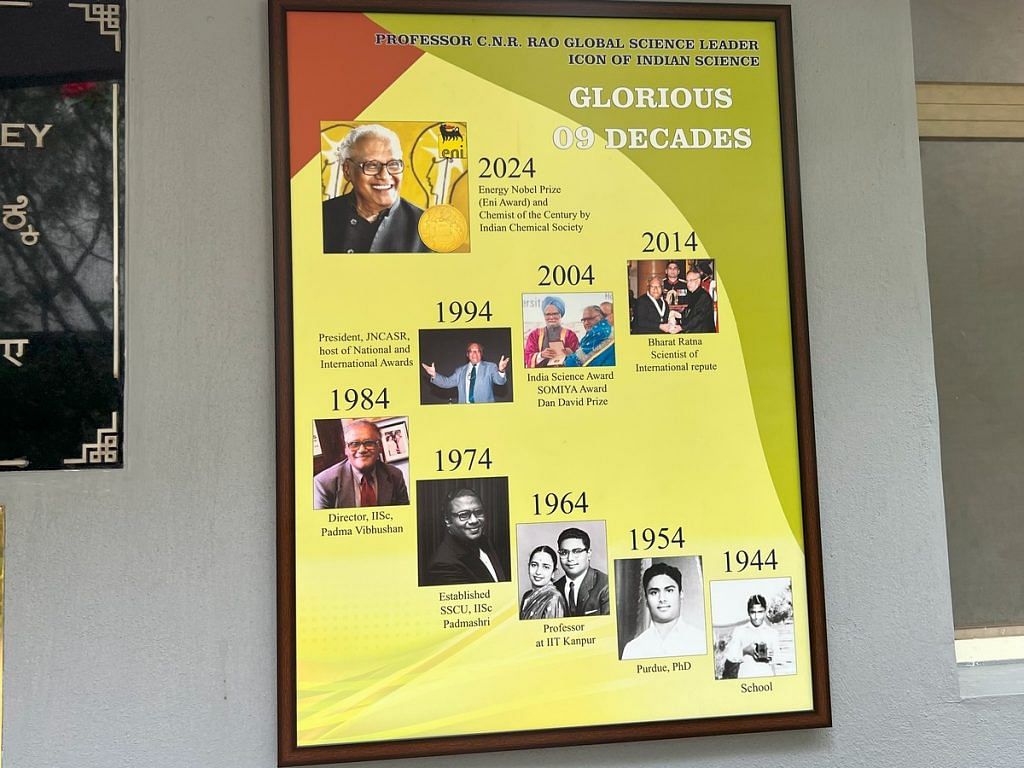
It’s a testament to the dazzling career of one of India’s most prolific scientists. Rao has received the Shanti Swarup Bhatnagar Prize, the Hughes Medal, the Royal Medal, the National Order of Scientific Merit, the Padma Vibhushan, and the Padma Bhushan. He is only the third scientist after CV Raman and APJ Abdul Kalam to be awarded the Bharat Ratna.
But Rao, who has authored over 1,500 papers and more than 50 books, is more interested in the next big breakthroughs and the institute’s research processes. He sits in his office behind a large desk full of papers and files arranged by his staff. His aide and special projects coordinator, AN Jayachandra, translates his responses by his side.
“He has been publishing papers. That hasn’t stopped. We come here every day at 9.30 am and work here for two hours. He works with students closely and meets people daily,” said his wife Indumati.
The two have offices near each other. Indumati works on science exposure projects for children, while the professor remains immersed in institute work, as he has been for decades. Together, they want to make science more accessible in rural Karnataka.
Prof Rao is firm that young researchers should focus on their science without being bogged down by administrative tasks like securing financial grants.
Also Read: Ahmedabad lab is now predicting India’s climate future. It’s using ‘atomic time machines’
Spreading the word
The couple have a shared passion— spreading scientific awareness among rural children. To further this cause, they established the CNR Rao Education Foundation in 2005.
“He decided a few years ago that he wants to communicate science to young people,” said Indumati. “And my dream was to do something for rural children. So, we started this foundation for that purpose, and to also give back to the scientific community.”
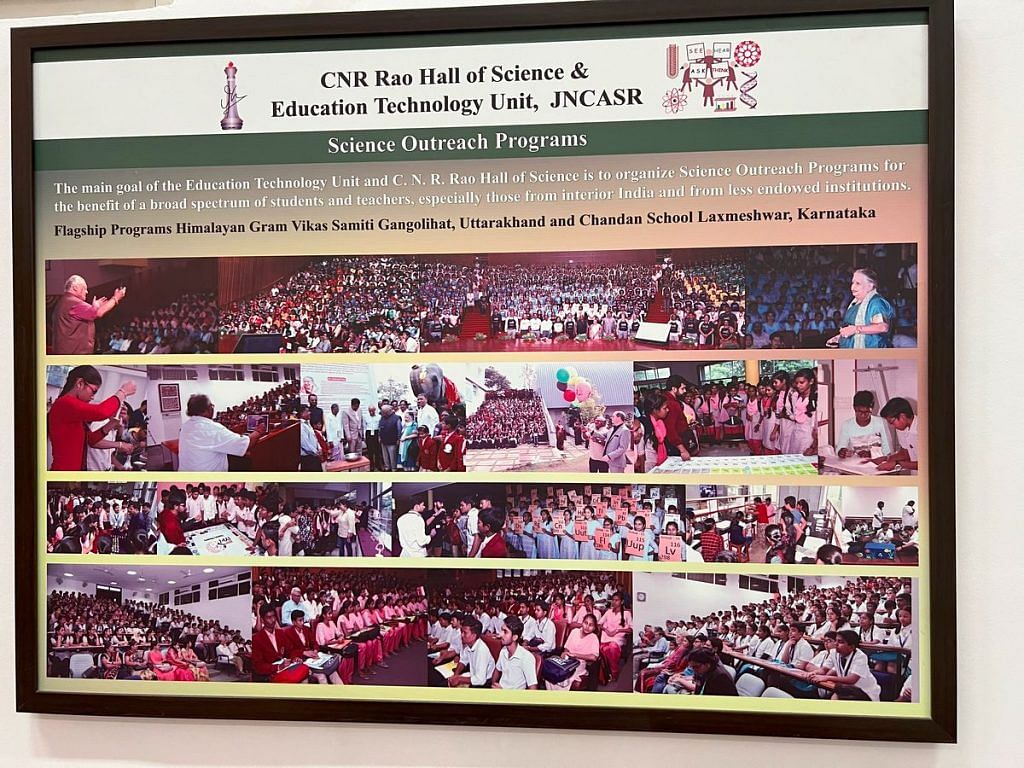
Indumati is currently busy translating a piece of science writing from English to Kannada, which will be distributed across rural schools.
The Foundation also built new gallery dedicated to Rao’s work. Alongside this building, there is an interactive science museum, envisioned by the scientist himself
Visitors can take part in table-top science experiments, view large-scale models of atomic structures, and learn about the lives of famous chemists through history.
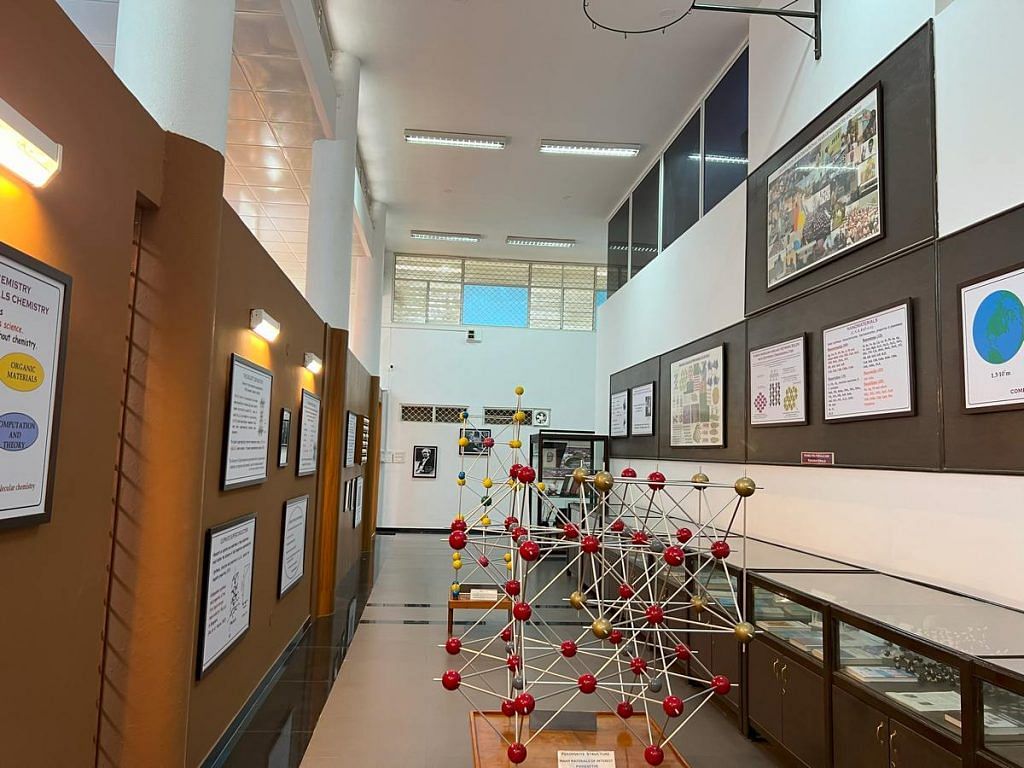
Madam Rao and Professor Rao, as they’re affectionately known, are also believers in integrating culture with science, particularly through music. Rao is deeply interested in the context in which science is understood in the world, as well as the intricate connections between science, the laws of nature, arts, and creativity. His idea of interdisciplinary learning extends beyond scientific research to include experiences like music.
Faculty don’t have to conform to any structure. They are free to choose the area of their work, and aid is facilitated to them on par with international standards. They can pursue their science at their free will, and that is a signature of this institute
-AN Jayachandra, special projects coordinator
“To be a complete person, it is not enough to do science only. There must also be exposure to culture, like music,” said Indumati, speaking for the two of them. “Every year, we invite a well-known artist who performs a concert at the institute for students and researchers, and musicians talk about their theory.”
The Raos are patrons of Hindustani classical music, and have followed a dinnertime tradition every day for decades— after their evening meal, they play a music recording or a playlist for 1.5 hours. No one talks during the “concert”.
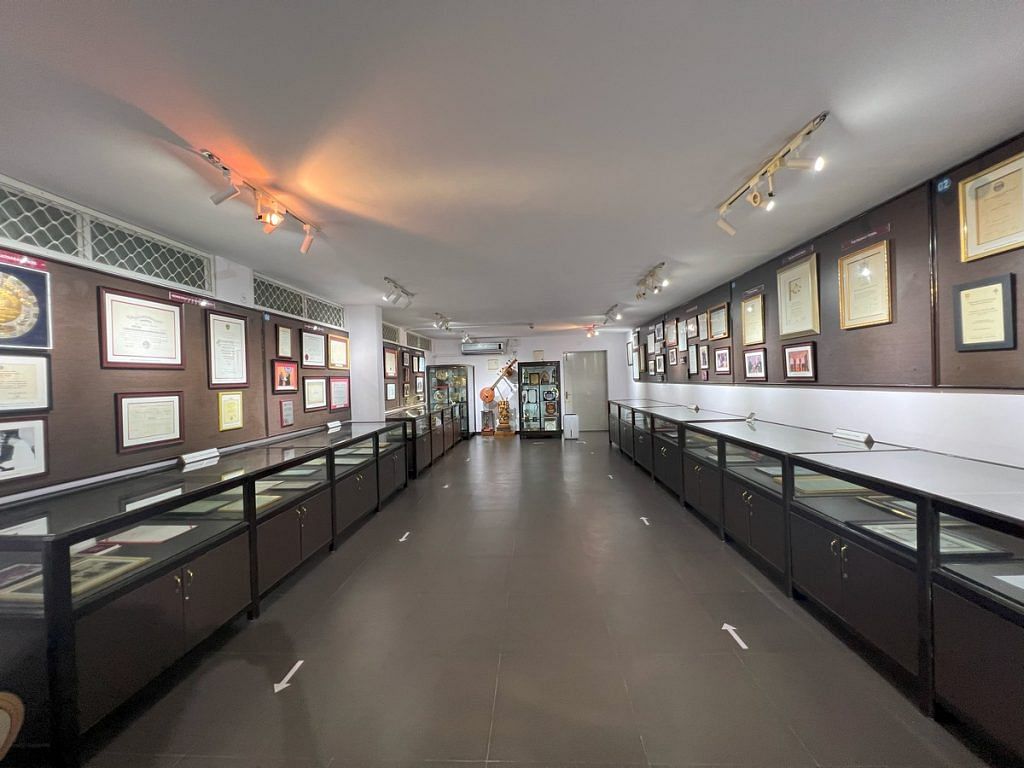
A culture of academic freedom
Within academia, Prof Rao is known for his clear vision as the head of JNCASR. He is firm that young researchers should focus on their science without being bogged down by administrative tasks like securing financial grants and other procedural necessities.
“Funding is always a challenge, but his problem-solving mentality has been a boon for everyone here. No matter the project, when we tell Professor Rao that there is a problem, there’s a solution a few days later,” said Jaishri Sanwal, a geoscientist at the institute.
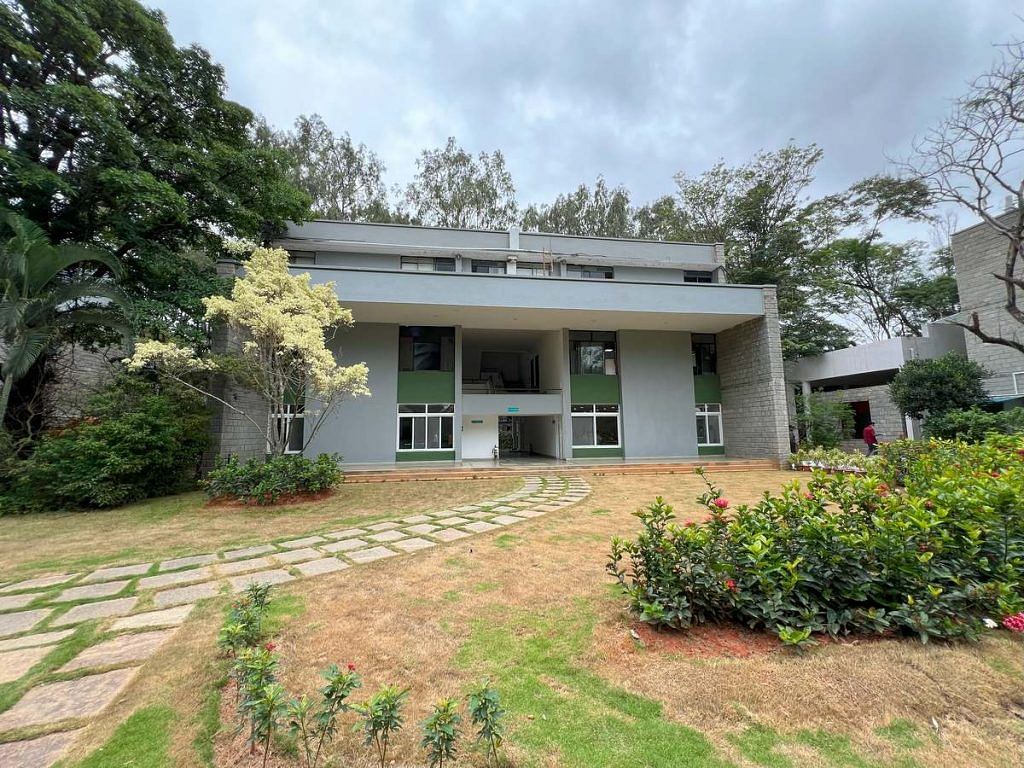
Sanwal, who works in an office full of rocks and fossils, explained that she doesn’t hold a teaching position, nor does she have a permanent one, but she has been working as a research scientist at JNCASR for just over a decade. Her research centres on studying paleo-earthquakes in the Himalayas for risk assessment and recreating ancient environments across India to help prepare for the future.
“The geodyamics unit here (now called geosciences unit), is very active here and we can feel Professor Rao’s legacy,” she said.
As an administrator Rao’s ability to identify impactful science and back it up with resources is widely recognised by faculty and researchers.
One can achieve when one contributes without self-interest. Once in a way, bright research ideas come in. Then we have made it
-CNR Rao
“The researchers here work on frontier areas of science,” said Rao’s aide Jayachandra. “Faculty don’t have to conform to any structure. They are free to choose the area of their work, and aid is facilitated to them on par with international standards. They can pursue their science at their free will, and that is a signature of this institute.”
The green JNCASR campus, which covers about 27 acres in the suburb of Jakkur, is not as expansive as many other leading scientific institutes, but it packs a punch. It’s research units cover a range of specialities, including materials, engineering mechanics, evolutionary biology, theoretical physics, and new chemistry, all bound together through interdisciplinary research.
Unlike other major research institutes with countless departments, work here is structured into a mere seven to nine major departments, with less than 30 researchers. But within these departments, researchers, scientists, and engineers have been working on everything from nanodevices and degenerative diseases to virology and ancient Indian climate.
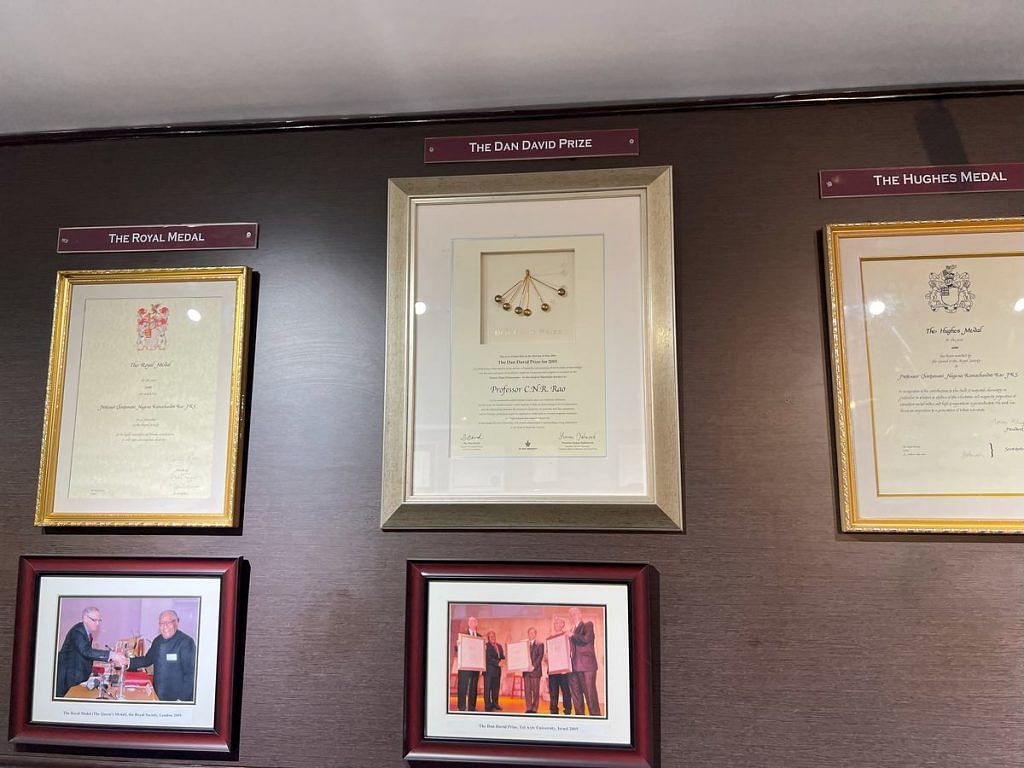
The close-knit campus environment facilitates spontaneous research ideas due to the way researchers get to interact with each other, including over casual chats, according to Ravi Manjithaya, head of neurosciences.
“Prof Rao has always been ahead of his time, and still is,” he said. “We do cutting-edge research at par with the rest of the world, even though we are surprisingly one of the smallest research institutes in the world. We consistently rank high, sometimes to our own surprise, and one of the main reasons is how so many departments are pushed to work together so closely.”
Last year, just like every other year, JNCASR was ranked in the top 30 of India’s National Institutional Ranking Framework (NIRF), the only autonomous institute under the Department of Science and Technology to achieve this. In international research rankings too, the small research institute consistently punches above its weight, with a high point being a global ranking of 7 by scientific publisher Nature in 2019.
The research at the institute is often innovative. Biotechnologist Dr. Sheeba Vasu, for example, works on biological clocks and what determines human sleep patterns.
“We live on earth, we have 24-hour clocks. However different organisms fit into various temporal niches beyond just mere response to sunlight. We ask in our labs, using flies, how clocks evolve biologically,” summed up Vasu, whose lab works at the intersection of neuroscience, biotechnology, and genetics.
On the administrative side, JNCASR’s faculty and staff hold a deep respect for Rao’s leadership, especially his policy of unburdening scientists from bureaucracy and paperwork.
“At what institute will a senior registrar and administrator be sitting like this, helping with interviews and arranging appointments,” Manjithaya laughed, pointing at Jayachandra seated across from him.
The close-knit campus environment facilitates spontaneous research ideas due to the way researchers get to interact with each other, including over casual chats, according to Ravi Manjithaya, head of neurosciences.
Also Read: ‘We are scientists, not beggars’. Indian Science Congress is in a war against govt
Legacy and future
Rao’s seminal work on solid state chemistry, materials, metal oxides and conductivity has led to advances in the fields of superconductivity, hybrid materials, nanomaterials, insulators, and more.
He is passionate about fostering stronger interdisciplinary research, both within India and internationally. His seven-decade-long experience in the Indian scientific community has only made him more optimistic.
As the Raos and the institute plan for their future, the next batch of PhD students has already arrived. Each department is hosting orientation sessions where the faculty introduce the students to the campus and their to-be colleagues. Around 30 young scholars, from all over the country, fresh from universities, introduce themselves to the people they will spend the next five years with, walking around campus, and looking inside laboratories with stars in their eyes.
“I am not disappointed by academia,” Rao said. We must work hard. One can achieve when one contributes without self-interest. Once in a way, bright research ideas come in. Then we have made it.”



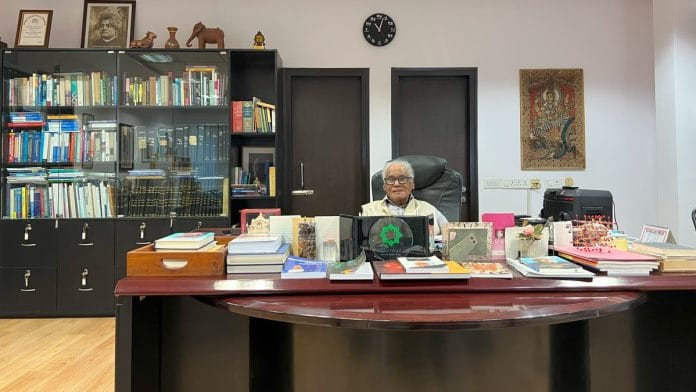



pls write about Dr. Sujata Bhat